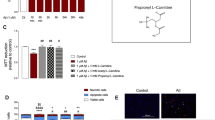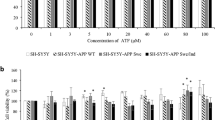Abstract
In Alzheimer's disease (AD) brain increased lipid peroxidation and decreased energy utilization are found. Mitochondria membranes contain a significant amount of arachidonic and linoleic acids, precursors of lipid peroxidation products, 4-hydroxynonenal (HNE) and 2-propen-1-al (acrolein), that are extremely reactive. Both alkenals are increased in AD brain. In this study, we examined the effects of nanomolar levels of acrolein on the activities pyruvate dehydrogenase (PDH) and α-ketoglutarate dehydrogenase (KGDH), both reduced nicotinamide adenine dinucleotide (NADH)-linked mitochondrial enzymes. Acrolein decreased PDH and KGDH activities significantly in a dose-dependent manner. Using high performance liquid chromatography coupled to mass spectrometry (HPLCMS), acrolein was found to bind lipoic acid, a component in both the PDH and KGDH complexes, most likely explaining the loss of enzyme activity. Acrolein also interacted with oxidized nicotinamide adenine dinucleotide (NAD+) in such a way as to decrease the production of NADH. Acrolein, which is increased in AD brain, may be partially responsible for the dysfunction of mitochondria and loss of energy found in AD brain by inhibition of PDH and KGDH activities, potentially contributing to the neurodegeneration in this disorder.
Similar content being viewed by others
References
Blass JP (2000) The mitochondrial spiral: an adequate cause of dementia in Alzheimer syndrome.Ann. NY Acad. Sci. USA 924, 170–183.
Brown JP and RN Perham (1976) Selective inactivation of the transacylase components of the 2-oxo acid dehydrogenase multienzyme complexes of Escherichia coli.Biochem. J. 155, 419–427.
Boveris A, N Oshino and B Chance (1972) The cellular production of hydrogen peroxide.Biochem. J. 128, 617–630.
Butterfield DA (2002) Amyloid beta-peptide (1–42)-induced oxidative stress and neurotoxicity: implications for neurodegeneration in Alzheimer's disease brain. A review.Free Radic. Res. 36, 1307–1313.
Butterfield DA and C Lauderback (2002) Lipid peroxidation and protein oxidation in Alzheimer's disease brain: potential causes and consequences involving amyloid beta-peptide-associated free radical oxidative stress.Free Radic. Biol. Med. 32, 1050–1060.
Butterfield DA and ER Stadtman (1997) Protein oxidation processes in brain aging.Adv. Cell. Aging Gerontol. 2, 161–191.
Butterfield DA, J Drake, C Pocernich and A Castegna (2001) Evidence of oxidative damage in Alzheimer's disease brain: central role for amyloid beta-peptide.Trends Mol. Med. 7, 548–554.
Butterfield DA, A Castegna, CM Lauderback and J Drake (2002) Review: evidence that amyloid beta-peptide-induced lipid peroxidation and its sequelae in Alzheimer's disease brain contributes to neuronal death.Neruobiol. Aging 23, 655–664.
Calingasan NY, K Uchida and GE Gibson (1999) Protein-bound acrolein: a novel marker of oxidative stress in Alzheimer's disease.J. Neurochem. 72, 751–756.
Castegna A, M Aksenov, M Aksenova, V Thongboonkerd, JB Klein, WM Pierce, R Booze, WR Markesbery and DA Butterfield (2002) Proteomic identification of oxidatively modified proteins in Alzheimer's disease brain. Part i: creatine kinase BB, glutamine synthase, and ubiquitin carboxy-terminal hydrolase L-1.Free Radic. Biol. Med. 33, 562–571.
Castegna A, V Thongboonkerd, JB Klein, B Lynn, WR Markesbery and DA Butterfield (2003) Proteomic identification of nitrated proteins in Alzheimer's disease brain.J. Neurochem. 85, 1394–1401.
Chung FL, R Young and SS Hecht (1984) Formation of cyclic 1, N2-propanodeoxyguanosine adducts in DNA upon reaction with acrolein or crotonaldehyde.Cancer Res. 44, 990–995.
Gibson GE, KF Sheu, JP Blass, A Baker, KC Carlson, B Harding and P Perrino (1988) Reduced activities of thiamine-dependent enzymes in the brains and peripheral tissues of patients with Alzheimer's disease.Arch. Neurol. 45, 836–840.
Gibson GE, DFR Sheu and JP Blass (1998) Abnormalities of mitochondrial enzmes in Alzheimer disease.J. Neural. Transm. 105, 855–870.
Hensley K, N Hall, R Subramaniam, P Cole, M Harris, M Aksenov, M Aksenova, SP Gabbita, JF Wu, JM Carney, M Lovell, WR Markesbery and DA Butterfield (1995) Brain regional correspondence between Alzheimer's disease histopathology and biomarkers of protein oxidation.J. Neurochem. 65, 2146–2156.
Horton ND, BM Mamiya and JP Kehrer (1997) Relationships between cell density, glutathione and proliferation of A549 human lung adenocarcinoma cells treated with acrolein.Toxicology 122, 111–122.
Lauderback CM, JM Hackett, FF Huang, JN Keller, LI Szweda, WR Markesbery and DA Butterfield (2001) The glial glutamate transporter, GLT-1, is oxidatively modified by 4-hydroxy-2-nonenal in the Alzheimer's disease brain.J. Neurochem. 78, 413–416.
Lovell MA, C Xie and WR Markesbery (2001) Acrolein, a product of lipid peroxidation, is increased in the brain in Alzheimer's disease and is toxic to primary hippocampal cultures.Neurobiol. Aging 22, 187–194.
Lovell MA, WD Ehmann, SM Butler and WR Markesbery (1995) Elevated thiobarbituric acid-reactive substances and antioxidant enzyme activity in the brain in Alzheimer's disease.Neurology 45, 1594–1601.
Lovell MA, C Xie and WR Markesbery (2000) Acrolein a product of lipid peroxidation, inhibits glucose and glutamate uptake in primary neuronal cultures. Free Radic. Biol. Med.,29, 714–720.
Lyras L, NJ Cairns, A Jenner, P Jenner and B Halliwell (1997) An assessment of oxidative damage to proteins, lipids, and DNA in brain from patients with Alzheimer's disease.J. Neurochem. 68, 2061–2069.
Markesbery WR and MA Lovell (1998) Four-hydroxynonenal, a product of lipid peroxidation, is increased in the brain in Alzheimer's disease.Neurobiol. Aging 19, 33–36.
Marnett LJ (1994) DNA adducts of α,βs-unsaturated aldehydes and dicarbonyl compounds.IARC Sci. Publ. 125, 151–163.
Mattson MP (2000) Apoptosis in neurodegenerative disorders.Nat. Rev. Mol. Cell Biol. 1, 120–129.
Ohno Y and K Ormstad (1985) Formation, toxicity and inactivation of acrolein during biotransformation of cyclophosphamide as studied in freshly isolated cells from rat liver and kidney.Arch. Toxicol. 57, 99–103.
Picklo MJ and TJ Montine (2001) Acrolein inhibits respiration in isolated brain mitochondria.Biochim. Biophys. Acta. 1535, 145–152.
Pocernich CB, AL Cardin, CL Racine, CM Lauderback and DA Butterfield (2001) Glutathione elevation and its protective role in acrolein-induced protein damage in synaptosomal membranes: relevance to brain lipid peroxidation in neurodegenerative disease.Neurochem. Int. 39, 141–149.
Ruggiero FM, F Cafagna, V Petruzzella, MN Gadaleta and E Quagliariello (1992) Lipid composition in synaptic and nonsynaptic mitochondria from rat brains and effect of aging.J. Neurochem. 59, 487–491.
Sayre LM, DA Zelasko, PLR Harris, G Perry, RG Salomon and MA Smith (1997) 4-hydroxynonenal-derived advanced lipid peroxidation end products are increased in Alzheimer's disease.J. Neurochem. 68, 2092–2097.
Smith MA, PLR Harris, LM Sayre and G Perry (1997) Iron accumulation in Alzheimer disease is a source of redox-generated free radicals.Proc. Natl. Acad. Sci. USA 94, 9866–9868.
Tirmenstein MA, PI Mathias, JE Snawder, HE Wey and M Toraason (1997) Antimony-induced alterations in thiol homeostasis and adenine nucleotide status in cultured cardiac myocytes.Toxicol. 119, 203–211.
Turrens J (1997) Superoxide production by the mitochondrial respiratory chain.Biosci. Rep. 17, 3–8.
Uchida K, M Kanematsu, K Sakai, T Matsuda, N Hattori, Y Mizuno, D Suzuki, T Miyata, N Noguchi, E Niki and T Osawa (1998) Protein-bound acrolein: potential markers for oxidative stress.Proc. Natl. Acad. Sci. USA 95, 4882–4887.
Author information
Authors and Affiliations
Corresponding author
Rights and permissions
About this article
Cite this article
Pocernich, C.B., Butterfield, D.A. Acrolein inhibits NADH-linked mitochondrial enzyme activity: Implications for Alzheimer's disease. neurotox res 5, 515–519 (2003). https://doi.org/10.1007/BF03033161
Received:
Revised:
Accepted:
Issue Date:
DOI: https://doi.org/10.1007/BF03033161




